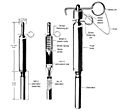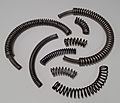Spring (device) facts for kids
A spring is a clever device, usually made from metal, most often steel. Think of it like a special piece of metal that can be squeezed or stretched. When you let go, it bounces back to its original shape and size. This is because springs store energy when you push or pull them.
Springs come in many shapes and sizes. Some are designed to be pushed, like the ones in a pen. Others are made to be pulled, like the springs in a trampoline. You might also find "gas-springs" which use gas pressure, often seen helping to lift the tailgate of a car.
The History of Springs
People have used simple springs for a very long time! One of the earliest examples is the bow and arrow, where the flexible wood acts like a spring to launch the arrow.
Later, during the Bronze Age, people started using more complex spring-like tools, such as tweezers. An ancient inventor named Ctesibius of Alexandria even figured out how to make bronze act more like a spring. He did this by adding more tin to the bronze and then hammering it to make it harder.
Coiled springs, which look like a spiral, first appeared around the 1400s. They were used in door locks. Soon after, the first clocks powered by springs were invented. By the 1500s, these clocks became smaller and turned into the first large watches.
In 1676, a British scientist named Robert Hooke discovered an important rule about springs. He found that the force a spring pushes or pulls with is directly related to how much it's stretched or squeezed. This rule is now known as Hooke's law.
Where We Use Springs
Springs are everywhere in our daily lives! They help things move, absorb shocks, and keep things in place. Here are some common uses:
- Vehicle suspension: Springs help your car ride smoothly over bumps.
- Watches: Tiny springs called balance springs help mechanical clocks and watches keep accurate time.
- Jewelry: Springs are used in clasps to keep necklaces and bracelets secure.
- Lock mechanisms: Springs help the parts inside a lock move correctly when you use a key.
- Pop-open devices: Springs make things like CD players and tape recorders open smoothly.
- Pens: A small spring makes the pen tip pop out and retract.
- Spring mattresses: Many mattresses have springs inside to make them comfortable.
- Slinky: This classic toy is just a long, coiled spring!
- Trampolines: Springs around the edge give you that amazing bounce.
- Pogo sticks: A big spring inside helps you jump high.
- Spring shoes: Some shoes have springs for extra bounce or comfort.
- Buckling spring keyboards: These keyboards use springs under each key for a unique feel.
- Upholstery: Springs are used inside furniture like sofas for comfort and support.
- Toys: Many toys use springs for movement or sound.
- Airsoft guns and firearms: Springs are essential for their firing mechanisms.
- Reverberation devices: Springs can create echo effects in music equipment.
Images for kids
-
The English longbow – a simple but very powerful spring made of yew, measuring 2 meters long, with a 467 Newton draw weight, with each limb functionally a cantilever spring.
-
Military booby trap firing device from USSR (normally connected to a tripwire) showing spring-loaded firing pin
-
A spiral torsion spring, or hairspring, in an alarm clock.
-
Leaf spring on a truck
See also
 In Spanish: Resorte para niños
In Spanish: Resorte para niños










